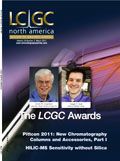The LCGC Awards
LCGC North America
There are many enjoyable aspects to my role here at LCGC. None rivals the pride, however, I feel in announcing the winners of the 2011 LCGC Lifetime Achievement and Emerging Leader in Chromatography Awards.
There are many enjoyable aspects to my role here at LCGC. None rivals the pride, however, I feel in announcing the winners of the 2011 LCGC Lifetime Achievement and Emerging Leader in Chromatography Awards.

Laura Bush
The winner of the 2011 Lifetime Achievement award is James W. Jorgenson, the William Rand Kenan, Jr. Distinguished Professor in the Department of Chemistry at the University of North Carolina at Chapel Hill. Jorgenson has taught and conducted research at that institution since he joined the faculty there in 1979, upon completing his doctorate.
Jorgenson made his mark very early in his career with his breakthrough work on capillary electrophoresis (CE). Jorgenson realized that to achieve high-resolution separations with CE, smaller capillaries and better detectors were needed. He then proceeded to develop systems that could achieve separations equivalent to hundreds of thousands of theoretical plates in a few minutes. This work developed CE as a viable and powerful tool for microscale chemical separations; capillary gel electrophoresis later enabled the sequencing of the human genome.
That achievement alone would be enough to make a career. But Jorgenson followed that up with other ground-breaking studies. His work on the use of ultrahigh pressures in liquid chromatography, first published in 1999, is widely regarded as critical to the success of what is now known as ultrahigh-pressure liquid chromatography (UHPLC). He published some of the first work using capillary columns to dissipate the heat generated by high-pressure systems and demonstrated early high-pressure results at 100,000 psi on systems he built at the university.
Jorgenson also was one of the first to study multidimensional chromatography or multidimensional electrophoresis and coupled CE with high performance liquid chromatography (HPLC). Later, he went on to interface mass spectrometry to CE–HPLC to make a truly hyphenated system. He continues to pursue techniques of great peak capacity, such as LC–CE, as well as techniques with extreme resolving power, such as flow counterbalanced capillary electrophoresis (FCCE), to solve problems in complex mixture analysis. Jorgenson has received numerous awards and recognitions, holds six patents, has authored or coauthored more than 100 journal articles, and has served on the editorial boards of seven journals.
The winner of the LCGC 2011 Emerging Leader award is Dwight Stoll. Stoll is currently an Assistant Professor at Gustavus Adolphus College, Saint Peter, Minnesota, where he has taught since 2008. Beginning at the University of Minnesota and continuing at Gustavus Adolphus, Stoll developed fast, comprehensive two-dimensional high performance liquid chromatography (c2D-HPLC) as an analytical tool capable of quickly separating and quantifying hundreds of chemical constituents of complex mixtures. The principal goal of this work was to move 2D-LC from a niche technique used in proteomics, for use with very complex samples (containing thousands of components) and make it a much more practical, accessible method. When Stoll first began that work, state-of-the-art 2D-LC required up to 10 h for a full comprehensive 2D run if the resolution gained in the first dimension was not to be sacrificed in the second. Stoll designed and built a 2D-LC instrument that has many unique features and made it possible to do comprehensive 2D-LC with a peak capacity of more than 1000 in 30 min. Such peak capacities have a separating capacity equivalent to several hundred thousand plates in 1D-LC.
This month, I will be interviewing Jorgenson and Stoll in LCGC's Theater at Pittcon, in booth 3217. Stoll's interview will be held on Tuesday, March 22, at 10:00 am; the interview with Jorgenson will take place on Wednesday, March 16, at 10:30 am. For those of you unable to be there in person, we invite you to watch the video recording of the interviews, which will be posted on our web site by March 22 (www.chromatographyonline.com/LabTV). I also invite you to join me in congratulating them on their outstanding achievements.

Laura Bush
Editorial Director

Determining Enhanced Sensitivity to Odors due to Anxiety-Associated Chemosignals with GC
May 8th 2025Based on their hypothesis that smelling anxiety chemosignals can, like visual anxiety induction, lead to an increase in odor sensitivity, a joint study between the University of Erlangen-Nuremberg (Erlangen, Germany) and the Fraunhofer Institute for Process Engineering and Packaging (Freising, Germany) combined behavioral experiments, odor profile analysis by a trained panel, and instrumental analysis of odorants (gas chromatography-olfactometry) and volatiles (gas chromatography-mass spectrometry).
Investigating 3D-Printable Stationary Phases in Liquid Chromatography
May 7th 20253D printing technology has potential in chromatography, but a major challenge is developing materials with both high porosity and robust mechanical properties. Recently, scientists compared the separation performances of eight different 3D printable stationary phases.
Detecting Hyper-Fast Chromatographic Peaks Using Ion Mobility Spectrometry
May 6th 2025Ion mobility spectrometers can detect trace compounds quickly, though they can face various issues with detecting certain peaks. University of Hannover scientists created a new system for resolving hyper-fast gas chromatography (GC) peaks.

.png&w=3840&q=75)

.png&w=3840&q=75)



.png&w=3840&q=75)



.png&w=3840&q=75)











